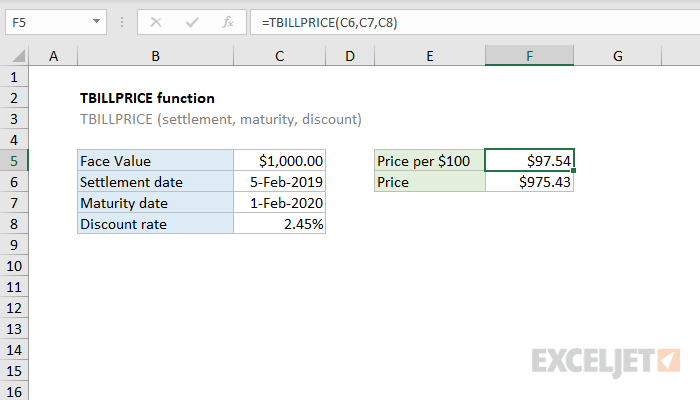Purpose
Return value
Syntax
=TBILLPRICE(settlement,maturity,discount)- settlement - Settlement date of the security.
- maturity - Maturity date of the security.
- discount - The discount rate for the security.
Using the TBILLPRICE function
The TBILLPRICE function returns the price per $100 face value for a Treasury bill, based on a settlement date, a maturity date, and a discount. In the example shown, the settlement date is 5-Feb-2019, the maturity date is 1-Feb-2020, and the discount is 2.45%. The formula in F5 is:
=TBILLPRICE(C6,C7,C8)
With these inputs, the TBILLPRICE function returns a price per $100 of $97.54, with currency number format applied.
To convert the face value of $1000 in cell C5 to a price using the value returned by TBILLPRICE, F6 contains this formula:
=F5/100*C5
Entering dates
In Excel, dates are serial numbers. Generally, the best way to enter valid dates is to use cell references, as shown in the example. To enter valid dates directly inside a function, the DATE function is the best option.
About treasury bills
A treasury bill (also called a T-Bill) is a short-term debt obligation issued by the US Treasury Department. T-Bills are sold in increments of $100, and have terms that range from a few days up to 52 weeks. Backed by US government, T-Bills are considered a low risk investment.
T-Bills are typically sold at a discount from par amount (face value), and the discount rate is determined at auction. However, T-bills can also be sold at a premium, when the price is greater than the par amount.
T-Bills do not offer regular interest payments like a coupon bond. However, when a T-Bill matures, the owner is paid it's par amount, or face value. When the par amount is greater than the purchase price, the difference (par value less purchase price) is the interest earned.










